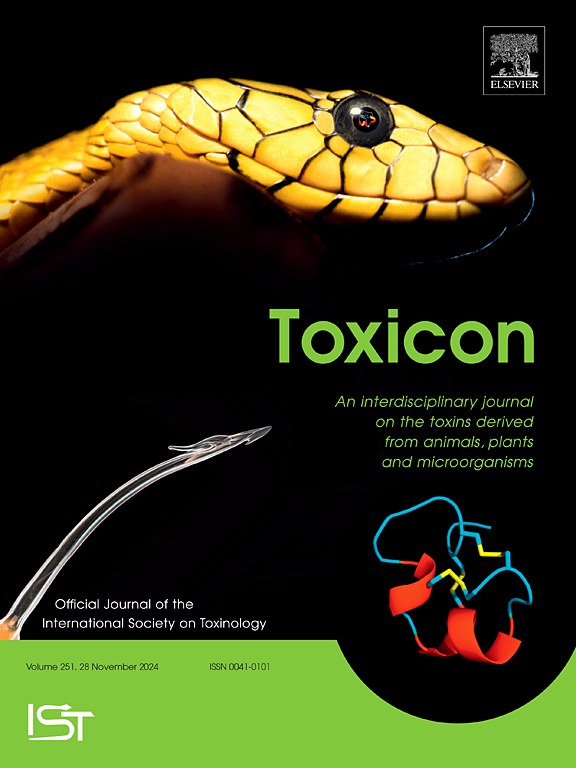Development of an analytical model for assessing the adsorptive properties of traditional medicinal formulations from Burkina Faso in relation to snake venom proteins
IF 2.4
4区 医学
Q2 PHARMACOLOGY & PHARMACY
引用次数: 0
Abstract
Introduction
The traditional treatment of snakebite envenomations across most regions of Burkina Faso relies on the use of formulations derived from the calcination of plants or specific plant parts. These preparations are subsequently administered either orally and/or applied topically to incisions made at the envenomation site.
Objective
Given the use of carbonised plants, this study was initiated to develop an analytical model for evaluating the adsorptive properties of these remedies in relation to the proteins found in snake venom.
Method
Traditional snakebite treatments were collected from three regions of the country and transported to the laboratory for analysis. The initial step involved characterising the physical and chemical properties of the remedies, such as granulometry and pH. Subsequent tests assessed the ability of the remedies to adsorb toxic venom proteins, using liquid chromatography coupled with high-resolution mass spectrometry (LC-HRMS). For those remedies exhibiting significant adsorption potential, the adsorbed venom proteins were identified using proteomics analysis.
Results
the results demonstrated that the recipe from Kampti, as well as activated charcoal (used as a reference adsorbent), exhibited noteworthy adsorption capacities. Both products showed a statistically significant reduction in the total quantity of venom adsorbed proteins. Kampti's recipe was particularly effective in adsorbing phospholipase A3, short neurotoxins 1 and snake venom metalloprotease.
Conclusion
This study bridges traditional ethnopharmacology with modern analytical chemistry, offering a promising framework for developing accessible and cost-effective adjunct therapies for snakebite envenomation in resource-limited settings.

开发了一种分析模型,用于评估布基纳法索传统药物配方对蛇毒蛋白的吸附特性
布基纳法索大多数地区蛇咬伤中毒的传统治疗依赖于使用从植物或特定植物部位煅烧中提取的配方。这些制剂随后口服和/或局部应用于中毒部位的切口。考虑到炭化植物的使用,本研究旨在建立一个分析模型,以评估这些药物与蛇毒中发现的蛋白质的吸附特性。方法收集全国3个地区的传统蛇咬伤治疗方法,运回实验室进行分析。最初的步骤包括表征药物的物理和化学性质,如粒度测定法和ph值。随后的测试使用液相色谱法和高分辨率质谱法(LC-HRMS)评估了药物吸附有毒毒液蛋白质的能力。对于那些表现出显著吸附潜力的补救措施,利用蛋白质组学分析鉴定了吸附的毒液蛋白。结果结果表明,该配方和活性炭(作为参考吸附剂)均表现出显著的吸附能力。两种产品在统计上都显示出毒液吸附蛋白总量的显著减少。Kampti的配方在吸附磷脂酶A3、短神经毒素1和蛇毒金属蛋白酶方面特别有效。结论本研究将传统民族药理学与现代分析化学相结合,为在资源有限的环境下开发可获得且具有成本效益的蛇咬中毒辅助疗法提供了一个有希望的框架。
本文章由计算机程序翻译,如有差异,请以英文原文为准。
求助全文
约1分钟内获得全文
求助全文
来源期刊

Toxicon
医学-毒理学
CiteScore
4.80
自引率
10.70%
发文量
358
审稿时长
68 days
期刊介绍:
Toxicon has an open access mirror Toxicon: X, sharing the same aims and scope, editorial team, submission system and rigorous peer review. An introductory offer Toxicon: X - full waiver of the Open Access fee.
Toxicon''s "aims and scope" are to publish:
-articles containing the results of original research on problems related to toxins derived from animals, plants and microorganisms
-papers on novel findings related to the chemical, pharmacological, toxicological, and immunological properties of natural toxins
-molecular biological studies of toxins and other genes from poisonous and venomous organisms that advance understanding of the role or function of toxins
-clinical observations on poisoning and envenoming where a new therapeutic principle has been proposed or a decidedly superior clinical result has been obtained.
-material on the use of toxins as tools in studying biological processes and material on subjects related to venom and antivenom problems.
-articles on the translational application of toxins, for example as drugs and insecticides
-epidemiological studies on envenoming or poisoning, so long as they highlight a previously unrecognised medical problem or provide insight into the prevention or medical treatment of envenoming or poisoning. Retrospective surveys of hospital records, especially those lacking species identification, will not be considered for publication. Properly designed prospective community-based surveys are strongly encouraged.
-articles describing well-known activities of venoms, such as antibacterial, anticancer, and analgesic activities of arachnid venoms, without any attempt to define the mechanism of action or purify the active component, will not be considered for publication in Toxicon.
-review articles on problems related to toxinology.
To encourage the exchange of ideas, sections of the journal may be devoted to Short Communications, Letters to the Editor and activities of the affiliated societies.
 求助内容:
求助内容: 应助结果提醒方式:
应助结果提醒方式:


